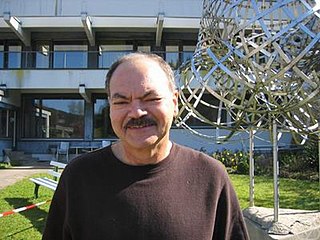
Numerical analysis is the study of algorithms that use numerical approximation for the problems of mathematical analysis. It is the study of numerical methods that attempt at finding approximate solutions of problems rather than the exact ones. Numerical analysis finds application in all fields of engineering and the physical sciences, and in the 21st century also the life and social sciences, medicine, business and even the arts. Current growth in computing power has enabled the use of more complex numerical analysis, providing detailed and realistic mathematical models in science and engineering. Examples of numerical analysis include: ordinary differential equations as found in celestial mechanics, numerical linear algebra in data analysis, and stochastic differential equations and Markov chains for simulating living cells in medicine and biology.

Computational physics is the study and implementation of numerical analysis to solve problems in physics. Historically, computational physics was the first application of modern computers in science, and is now a subset of computational science. It is sometimes regarded as a subdiscipline of theoretical physics, but others consider it an intermediate branch between theoretical and experimental physics — an area of study which supplements both theory and experiment.
In numerical analysis, a multigrid method is an algorithm for solving differential equations using a hierarchy of discretizations. They are an example of a class of techniques called multiresolution methods, very useful in problems exhibiting multiple scales of behavior. For example, many basic relaxation methods exhibit different rates of convergence for short- and long-wavelength components, suggesting these different scales be treated differently, as in a Fourier analysis approach to multigrid. MG methods can be used as solvers as well as preconditioners.
Computational mechanics is the discipline concerned with the use of computational methods to study phenomena governed by the principles of mechanics. Before the emergence of computational science as a "third way" besides theoretical and experimental sciences, computational mechanics was widely considered to be a sub-discipline of applied mechanics. It is now considered to be a sub-discipline within computational science.
Lloyd Nicholas Trefethen is an American mathematician, professor of numerical analysis and head of the Numerical Analysis Group at the Mathematical Institute, University of Oxford.
Numerical linear algebra, sometimes called applied linear algebra, is the study of how matrix operations can be used to create computer algorithms which efficiently and accurately provide approximate answers to questions in continuous mathematics. It is a subfield of numerical analysis, and a type of linear algebra. Computers use floating-point arithmetic and cannot exactly represent irrational data, so when a computer algorithm is applied to a matrix of data, it can sometimes increase the difference between a number stored in the computer and the true number that it is an approximation of. Numerical linear algebra uses properties of vectors and matrices to develop computer algorithms that minimize the error introduced by the computer, and is also concerned with ensuring that the algorithm is as efficient as possible.

Computational mathematics is an area of mathematics devoted to the interaction between mathematics and computer computation.
In numerical mathematics, relaxation methods are iterative methods for solving systems of equations, including nonlinear systems.
David M. Young Jr. was an American mathematician and computer scientist who was one of the pioneers in the field of modern numerical analysis/scientific computing.
Special functions are particular mathematical functions that have more or less established names and notations due to their importance in mathematical analysis, functional analysis, geometry, physics, or other applications.
Mathematics is a broad subject that is commonly divided in many areas that may be defined by their objects of study, by the used methods, or by both. For example, analytic number theory is a subarea of number theory devoted to the use of methods of analysis for the study of natural numbers.
The Holomorphic Embedding Load-flow Method (HELM) is a solution method for the power-flow equations of electrical power systems. Its main features are that it is direct and that it mathematically guarantees a consistent selection of the correct operative branch of the multivalued problem, also signalling the condition of voltage collapse when there is no solution. These properties are relevant not only for the reliability of existing off-line and real-time applications, but also because they enable new types of analytical tools that would be impossible to build with existing iterative load-flow methods. An example of this would be decision-support tools providing validated action plans in real time.
The following is a timeline of numerical analysis after 1945, and deals with developments after the invention of the modern electronic computer, which began during Second World War. For a fuller history of the subject before this period, see timeline and history of mathematics.
Vladimir P. Gerdt was a Russian mathematician and a full professor at the Joint Institute for Nuclear Research (JINR) where he was the head of the Group of Algebraic and Quantum Computations. His research interests were concentrated in computer algebra, symbolic and algebraic computations, algebraic and numerical analysis of nonlinear differential equations, polynomial equations, applications to mathematics and physics, and quantum computation with over 210 published articles.

Edward Barry Saff is an American mathematician, specializing in complex analysis, approximation theory, numerical analysis, and potential theory.
Probabilistic numerics is an active field of study at the intersection of applied mathematics, statistics, and machine learning centering on the concept of uncertainty in computation. In probabilistic numerics, tasks in numerical analysis such as finding numerical solutions for integration, linear algebra, optimization and simulation and differential equations are seen as problems of statistical, probabilistic, or Bayesian inference.

Daniel B. Szyld is an Argentinian and American mathematician who is a professor at Temple University in Philadelphia. He has made contributions to numerical and applied linear algebra as well as matrix theory.




